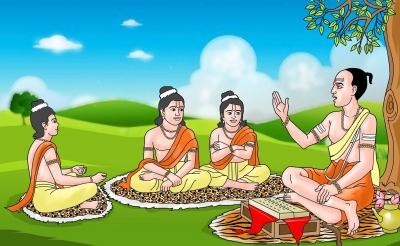
Vishnu Sharma is said to be an Indian scholar and author who is believed to have written the Panchatantra collection of fables. The exact period of the composition of the Panchatantra is uncertain, and estimates vary from 1200 BCE to 300 CE scholars place him in the 3rd century BCE.
Various locations where the text was composed have been proposed but this has been controversial. Some of the proposed locations include Kashmir, Southwestern or South India. The text’s original language was likely Sanskrit. Though the text is now known as Panchatantra, the title found in old manuscript versions varies regionally, and includes names such as Tantrakhyayika, Panchakhyanaka, Panchakhyana and Tantropakhyana. The suffix akhyayika and akhyanaka mean “little story” or “little story book” in Sanskrit.
The text was translated into Pahlavi in 550 CE, which forms the latest limit of the text’s existence. The earliest limit is uncertain. It quotes identical verses from Arthasastra, which is broadly accepted to have been completed by the early centuries of the Common Era. According to Olivelle, “the current scholarly consensus places the Panchatantra around 300 CE, although we should remind ourselves that this is only an educated guess”. The text quotes from older genre of Indian literature, and legends with anthropomorphic animals are found in more ancient texts dated to the early centuries of the 1st millennium BCE such as the chapter 4.1 of the Chandogya Upanishad. According to Gillian Adams, Panchatantra may be a product of the Vedic period, but its age cannot be ascertained with confidence because “the original Sanskrit version has been lost”.
Picture Credit : Google

